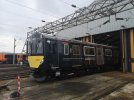If I may pick up on a few technical points:
1) The charging rails will be in the four foot. These will basically be lengths of standard conductor rail as used in normal third rail territory. The rails will be earthed when there is no train above them (i.e. not live). Right from when Vivarail first started developing the system over 3 years ago, this modus operandi was agreed with ORR, who despite rumours have in fact been very sensible about this all along. The charging rails will only be energised once a series of Wifi interlocks combined with hard-wired position sensors has proven beyond reasonable doubt that the train is the correct train, has stopped in the right place, and is safe to receive charge.
2) The pickup shoes will be 'top contact' and retractable. They will be deployed just before the train comes to a halt. They will then be retracted before the train departs from the charging station.
3) The charging point will be at West Ealing station, in the bay platform. It will consist of two separate trackside charging containers (with storage batteries and switchgear inside them), each connected with a set of charge rails, one serving each Driving Motor car (where the onboard batteries are). This allows for some redundancy, i.e. if one trackside charger fails, the train could still be charged from the other one. There will not be a charging point at Greenford.
4) It is all Vivarail's design, has nothing to do with Alstom etc.
5) The train for the GWR trial will be 230001, in 3-car formation with a toilet in the middle car. It's the same train as demonstrated by Vivarail at COP26 back in November, with very little mods to the interior layout, except for the reinstatement of a few extra seats. The toilet is basically only there because all trains operated by GWR have to have a toilet regardless of the route they are operating on. However, because of this, it will be ever so slightly too long for some of the platforms therefore the outermost passenger doors will become 'crew only' doors.
6) It is the hope, certainly from Vivarail's perspective, that this system will be rolled out to many more rail routes in the UK and possibly abroad in order to provide 'electrification by other means'. Whether that is with Class 230s is another matter. In principle the technology could be fitted to other types of rolling stock.

